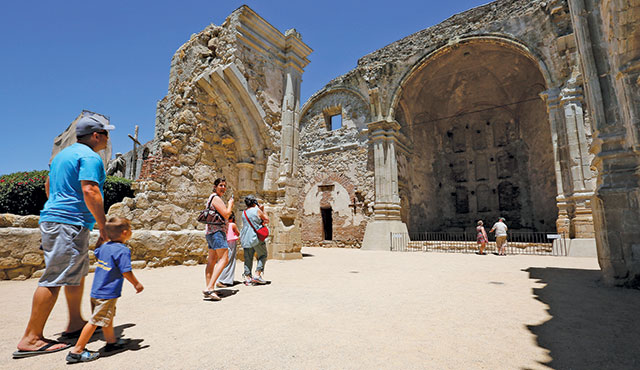Mission San Juan Capistrano, like history, has evolved and grown over time. In the 21st century the Mission is a place that celebrates diversity, its rich Catholic roots, and its diverse chapters over the last 245 years. The Mission today celebrates Native American history in a way that could not have happened 20 years ago. To judge the 18th-century leaders and landmarks by the lens of today is to negate the chance to learn how we have changed and evolved as a society. Under this lens, as President Obama said generally, “there will be no heroes.”
Since 2003, we have worked tirelessly to shift our site’s story/history-telling point of view. In 2003 the Mission’s museum experience was limited, and generally was one that offered a traditional view. It seemed an invisible line existed that resulted in not addressing the history of our First People. Over the past 17 years that has changed with the advent of a 360-degree advisory committee comprised of history scholars and Native American educators, all cultivating a close working relationship with Native Americans of the area. Together they have developed new museum exhibits, eliminated outdated and offensive dioramas and depictions, and included local tribal members in events and demonstrations as part of our regular ongoing offerings.
We now host an annual Day of Remembrance annual bell ringing to publicly celebrate the rich contributions of our original builders and to remember their eventual demise while attending Mass on Dec. 8, 1812. As baptized Catholics, they perished in an earthquake that brought down the Great Stone Church, leaving it in ruins. It took nearly 190 years to have this event, and it is the product of the 21st-century recognition of the importance of our native people in this landmark’s physical and historic context. Not a tradition that emanated from long ago, but one that was made possible as the times have changed.
Wherever possible we have strived to listen, learn and grow. We have strengthened our tour guide training because of concerns about the messaging of the contributions of our Native American history. All of our award-winning audio tours and exhibits have been crafted with an eye for inclusion–long before it became “a thing to be.” We have held lectures to showcase our historic diversity and support learning more about how Father Serra and the Native American community saw and interacted with each other. We have stocked our store with works that include criticisms of our history, and we have made sure at every opportunity to take a moment to always publicly appreciate our native builders and their subsequent ancestors who remain tied to the Mission site through their history. We will continue to improve our efforts along the way and seek out input from builders, scholars, and teachers. We proudly provide Native American history storytelling by acclaimed educator Jacque Nunez, and we have often sought her, and others input along the way.
Our inclusive efforts are rooted in the value of doing the right thing long before it became a movement. This evolution has not always been met with welcome or ease, but it has been worth doing. We are far from perfect, but we have an eye to an ever-changing future, and plan to continue to grow and expand our efforts. The Foundation and staff are deeply committed to honoring and celebrating the builders of the Mission, the long history of diversity represented, the inclusion of women in its depiction of history, and the conversation about inclusion. Mission San Juan Capistrano is the leading mission in the State for its quality museum exhibits, education programming, public programming and more. There are many stories to tell, and many ways of doing so. We will continue to evolve and we will continue to look for descendants of the original builders to help us along the way.
To casually suggest a trip to the Mission, including the 4th-grade field trips by tens of thousands of students each year, portends a racist experience is to suggest that we deny the opportunity to teach and thus impact, and that is akin to censorship. We must advocate that this landmark, in the 21st century is worth learning from, no matter the climate.
In fact, it might be the perfect setting for some of the more difficult conversations we face today.

